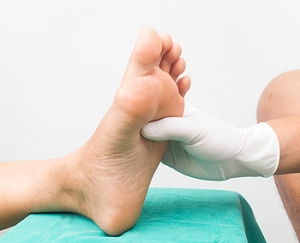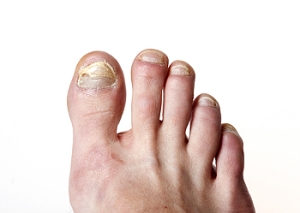
The Definition of a Podiatrist
 The medical field that is known as podiatric medicine focuses on correcting and maintaining foot and ankle health. Mandatory schooling consists of enrolling in podiatric school after completing a bachelor's degree. This is followed by completing a residency program that teaches future podiatrists how to apply the knowledge and concepts they have learned in medical school. Many students choose to join a fellowship program, which can help them to determine what type of podiatric skill they can excel at. There are several ways to practice this type of medicine, including having a private office, working with a group of other podiatrists, or working in a hospital or similar environment. If you would like to learn about how to diagnose and treat disorders of the feet, it may be beneficial to pursue a career in podiatry.
The medical field that is known as podiatric medicine focuses on correcting and maintaining foot and ankle health. Mandatory schooling consists of enrolling in podiatric school after completing a bachelor's degree. This is followed by completing a residency program that teaches future podiatrists how to apply the knowledge and concepts they have learned in medical school. Many students choose to join a fellowship program, which can help them to determine what type of podiatric skill they can excel at. There are several ways to practice this type of medicine, including having a private office, working with a group of other podiatrists, or working in a hospital or similar environment. If you would like to learn about how to diagnose and treat disorders of the feet, it may be beneficial to pursue a career in podiatry.
If you are dealing with pain in your feet and ankles, you may want to seek help from a podiatrist. Feel free to contact John McGhan, DPM from Gold Canyon Foot & Ankle. Our doctor can provide the care you need to keep you pain-free and on your feet.
What Is a Podiatrist?
A podiatrist is a doctor of podiatric medicine who diagnoses and treats conditions of the foot, ankle, and related structures of the leg. Your podiatrist may specialize in a certain field such as sports medicine, wound care, pediatrics, and diabetic care. Podiatrists have the ability to become board certified through training, clinical experience, and then taking an exam.
What Do Podiatrists Do?
On a daily basis, a podiatrist may perform the following activities:
- Diagnose foot ailments such as ulcers, tumors, fractures, etc.
- Use innovative methods to treat conditions
- Use corrective orthotics, casts, and strappings to correct deformities
- Correct walking patterns and balance
- Provide individual consultations to patients
It is very important that you take care of your feet. It’s easy to take having healthy feet for granted, however foot problems tend to be among the most common health conditions. Podiatrists can help diagnose and treat a variety of feet related conditions, so it is crucial that you visit one if you need assistance.
If you have any questions please feel free to contact our office located in Gold Canyon, AZ . We offer the newest diagnostic and treatment technologies for all your foot and ankle needs.
What is a Podiatrist?
A podiatrist is a Doctor of Podiatric Medicine who treats the foot, ankle, and related structures of the leg. If you are having any pain, injuries, or abnormalities in these areas, it is best that you seek help from a podiatrist.
Podiatrists complete four years of training in a podiatric medical school. Their training is like that of other physicians, and they may go on to complete a fellowship training after a residency training. Some podiatrists are board certified meaning they have advanced training, clinical experience, and have taken an exam to prove their skills. Certifying boards for podiatry are the American Board of Foot and Ankle Surgery and the American Board of Podiatric Medicine. Podiatrists may work in private practices, hospitals, clinics, or they may even become professors at colleges of podiatric medicine.
While in college, those who want to be podiatrists often take biology, chemistry, and physics classes in preparation for podiatry school. In podiatry school, students study how the bones, nerves, and muscles work together to help you move around. Additionally, they study injuries and how to properly diagnose and treat them. Admittance into podiatric medical school requires the completion of 90 semester hours of undergraduate study with a good grade point average, and acceptable scores on the MCAT (Medical College Admission Test)
Podiatrists treat many different conditions such as: aching feet, ankle pain, bunions, corns, hammertoes, fungus, ingrown toenails, plantar fasciitis, sprains and more. Common forms of treatment for these conditions are physical therapy, drugs, or surgery. Podiatrists may also recommend corrective shoe inserts, custom-made shoes, plaster casts, and strappings to correct deformities.
Even if you are someone whose feet are in generally good condition, you should still visit a podiatrist to have your feet properly exfoliated and maintained, or to make sure you are looking after your feet properly.
What Causes an Ingrown Toenail?
 Ingrown toenails can be incredibly uncomfortable, sensitive to the touch, and can cause a great deal of pain. Ingrown toenails can be caused by trimming the toenails too short, injury to the toenail, having curved toenails due to genetics, wearing ill-fitting shoes that are too tight, and poor hygiene. If left untreated, the toenail may become infected, causing drainage and bleeding. The affected toe may become swollen and red as well. Some patients have found relief by soaking their feet in a bath of warm water and epsom salts, and by wearing comfortable shoes. If you feel you have developed an ingrown toenail, please consult with a podiatrist for a proper diagnosis and advised treatment plan.
Ingrown toenails can be incredibly uncomfortable, sensitive to the touch, and can cause a great deal of pain. Ingrown toenails can be caused by trimming the toenails too short, injury to the toenail, having curved toenails due to genetics, wearing ill-fitting shoes that are too tight, and poor hygiene. If left untreated, the toenail may become infected, causing drainage and bleeding. The affected toe may become swollen and red as well. Some patients have found relief by soaking their feet in a bath of warm water and epsom salts, and by wearing comfortable shoes. If you feel you have developed an ingrown toenail, please consult with a podiatrist for a proper diagnosis and advised treatment plan.
Ingrown toenails may initially present themselves as a minor discomfort, but they may progress into an infection in the skin without proper treatment. For more information about ingrown toenails, contact John McGhan, DPM of Gold Canyon Foot & Ankle. Our doctor can provide the care you need to keep you pain-free and on your feet.
Ingrown Toenails
Ingrown toenails are caused when the corner or side of a toenail grows into the soft flesh surrounding it. They often result in redness, swelling, pain, and in some cases, infection. This condition typically affects the big toe and may recur if it is not treated properly.
Causes
- Improper toenail trimming
- Genetics
- Improper shoe fitting
- Injury from pedicures or nail picking
- Abnormal gait
- Poor hygiene
You are more likely to develop an ingrown toenail if you are obese, have diabetes, arthritis, or have any fungal infection in your nails. Additionally, people who have foot or toe deformities are at a higher risk of developing an ingrown toenail.
Symptoms
Some symptoms of ingrown toenails are redness, swelling, and pain. In rare cases, there may be a yellowish drainage coming from the nail.
Treatment
Ignoring an ingrown toenail can have serious complications. Infections of the nail border can progress to a deeper soft-tissue infection, which can then turn into a bone infection. You should always speak with your podiatrist if you suspect you have an ingrown toenail, especially if you have diabetes or poor circulation.
If you have any questions, please feel free to contact our office located in Gold Canyon, AZ . We offer the newest diagnostic and treatment technologies for all your foot care needs.
Ingrown Toenails
Ingrown toenails (onychocryptosis) are a common foot ailment and it is very unpleasant to experience. The condition is caused by an increase in pressure from the ingrowth of the nail edge into the skin of the toe. Ingrown toenails commonly cause pain in those who experience them. In some cases, the skin surrounding the ingrown toenail may break which may lead bacteria to enter through and cause an infection. Common symptoms of this ailment include pain, redness, swelling, and warmth around the toe.
An imbalance between the size of the nail and the enlargement of the nail skin edge causes ingrown toenails. This condition is often caused by improperly trimming the toenails. If you are trying you cut your nails, you should always try to trim straight across instead of in a rounded shape. Ingrown toenails can also be an inherited condition and they may also be caused by improper shoe fitting.
Another common cause of the condition is wearing shoes that are either too small or too large. Other causes include poor foot hygiene, obesity, diabetes, arthritis, edema, and fungal infections. There are many risk factors that may make a person more likely to develop an ingrown toenail. Athletes who play “stop and start” sports such as tennis, soccer, and basketball are most likely to have ingrown toenails.
People who have diabetes, a compromised immune system, or poor circulation should immediately seek care from a podiatrist if they have an ingrown toenail. It is also recommended to seek professional assistance if at-home remedies are not successful within a week or if there is persistent pain.
Common Foot Conditions That Can Occur During Pregnancy
 Foot pain is a common ailment among women who are pregnant, and it is triggered for several reasons. This type of pain often develops as a result from the added weight of the growing fetus, hormonal changes, and a possible change of foot structure. The arch may disappear, and this may enable the feet to roll inward. The plantar fascia can become inflamed, and it may be difficult to walk. This is a band of tissue that connects the heels to the toes, and is located on the sole of the foot. Weight gain can add pressure to the plantar fascia, and mild relief may be found when larger shoes are worn that can accommodate the expanding feet. Many pregnant women find it helpful to elevate their feet as often as possible during the day, in addition to limiting salt intake. If you would like additional information about changes in the feet that can occur during pregnancy, please consult with a podiatrist.
Foot pain is a common ailment among women who are pregnant, and it is triggered for several reasons. This type of pain often develops as a result from the added weight of the growing fetus, hormonal changes, and a possible change of foot structure. The arch may disappear, and this may enable the feet to roll inward. The plantar fascia can become inflamed, and it may be difficult to walk. This is a band of tissue that connects the heels to the toes, and is located on the sole of the foot. Weight gain can add pressure to the plantar fascia, and mild relief may be found when larger shoes are worn that can accommodate the expanding feet. Many pregnant women find it helpful to elevate their feet as often as possible during the day, in addition to limiting salt intake. If you would like additional information about changes in the feet that can occur during pregnancy, please consult with a podiatrist.
Pregnant women with swollen feet can be treated with a variety of different methods that are readily available. For more information about other cures for swollen feet during pregnancy, consult with John McGhan, DPM from Gold Canyon Foot & Ankle. Our doctor will attend to all of your foot and ankle needs.
What Foot Problems Can Arise During Pregnancy?
One problem that can occur is overpronation, which occurs when the arch of the foot flattens and tends to roll inward. This can cause pain and discomfort in your heels while you’re walking or even just standing up, trying to support your baby.
Another problem is edema, or swelling in the extremities. This often affects the feet during pregnancy but tends to occur in the later stages.
How Can I Keep My Feet Healthy During Pregnancy?
- Wearing orthotics can provide extra support for the feet and help distribute weight evenly
- Minimize the amount of time spent walking barefoot
- Wear shoes with good arch support
- Wear shoes that allow for good circulation to the feet
- Elevate feet if you experience swelling
- Massage your feet
- Get regular, light exercise, such as walking, to promote blood circulation to the feet
If you have any questions please feel free to contact our office located in Gold Canyon, AZ . We offer the newest diagnostic and treatment technologies for all your foot and ankle needs.
Foot Care for Pregnant Women
The natural weight that pregnant women gain causes their center of gravity to be completely altered. This causes them to have a new weight-bearing stance which adds pressure to the knees and feet. As a result, pregnant women often experience severe foot pain. The two most common foot issues experienced by women in their pregnancies are edema and over-pronation. It is important for all pregnant women to learn more about how to take care of their feet so they are more comfortable during their pregnancy.
Over-pronation, which is commonly referred to as flat feet, is caused when a person’s arch flattens out upon weight bearing. This causes the person’s feet to roll inward while walking. Pregnant women often experience this due to the sudden weight they gain.
Edema, also referred as swelling in the feet, typically occurs in the later part of the pregnancy. It is the result of the extra blood accumulated in the pregnant woman’s body. The enlarged uterus puts more pressure on the blood vessels in the pelvis which causes leg circulation to slow down. This causes blood to pool in the lower extremities.
Fortunately, there are ways to treat both edema and over-pronation. Edema can be treated by elevating the foot as often as possible. Wearing proper fitting footwear will also be helpful for those with edema. A treatment method for over-pronation could be orthotics. Orthotic inserts should be designed with appropriate arch support and medial rear foot for your foot.
It is best for pregnant women to buy new shoes during the day, because this is the time where swelling is at its peak. Pregnant women also shouldn’t rush when buying shoes. It is always advised that you make sure your shoes fit properly but this is especially important during pregnancy.
If you are a pregnant woman, you should consult with a podiatrist in order to make sure your feet are healthy throughout the entirety of your pregnancy.
What Are My Next Steps When Diagnosed With Neuropathy?
 Peripheral neuropathy is a condition that impacts the nervous system, often causing complications with the feet. If the nerves in your feet become damaged, they are no longer able to regulate your body temperature, or signal pain as they normally would. Those afflicted with this condition relay experiencing tingling sensations, or numbness in their feet. Neuropathy can be common among diabetic patients, as they are more prone to having complications with their feet. This can be dangerous if wounds go undetected due to the lack of feeling in the feet, as it’s likely an infection may then form. If diagnosed with this condition, medication may be prescribed to help ease the common symptoms. Having a healthy diet, keeping your muscles active and strong, and regularly getting massages or acupuncture may also be helpful in relieving some of the symptoms. For a proper diagnosis and an advised treatment plan, it is suggested that you speak with a podiatrist for professional care.
Peripheral neuropathy is a condition that impacts the nervous system, often causing complications with the feet. If the nerves in your feet become damaged, they are no longer able to regulate your body temperature, or signal pain as they normally would. Those afflicted with this condition relay experiencing tingling sensations, or numbness in their feet. Neuropathy can be common among diabetic patients, as they are more prone to having complications with their feet. This can be dangerous if wounds go undetected due to the lack of feeling in the feet, as it’s likely an infection may then form. If diagnosed with this condition, medication may be prescribed to help ease the common symptoms. Having a healthy diet, keeping your muscles active and strong, and regularly getting massages or acupuncture may also be helpful in relieving some of the symptoms. For a proper diagnosis and an advised treatment plan, it is suggested that you speak with a podiatrist for professional care.
Neuropathy
Neuropathy can be a potentially serious condition, especially if it is left undiagnosed. If you have any concerns that you may be experiencing nerve loss in your feet, consult with John McGhan, DPM from Gold Canyon Foot & Ankle. Our doctor will assess your condition and provide you with quality foot and ankle treatment for neuropathy.
What Is Neuropathy?
Neuropathy is a condition that leads to damage to the nerves in the body. Peripheral neuropathy, or neuropathy that affects your peripheral nervous system, usually occurs in the feet. Neuropathy can be triggered by a number of different causes. Such causes include diabetes, infections, cancers, disorders, and toxic substances.
Symptoms of Neuropathy Include:
- Numbness
- Sensation loss
- Prickling and tingling sensations
- Throbbing, freezing, burning pains
- Muscle weakness
Those with diabetes are at serious risk due to being unable to feel an ulcer on their feet. Diabetics usually also suffer from poor blood circulation. This can lead to the wound not healing, infections occurring, and the limb may have to be amputated.
Treatment
To treat neuropathy in the foot, podiatrists will first diagnose the cause of the neuropathy. Figuring out the underlying cause of the neuropathy will allow the podiatrist to prescribe the best treatment, whether it be caused by diabetes, toxic substance exposure, infection, etc. If the nerve has not died, then it’s possible that sensation may be able to return to the foot.
Pain medication may be issued for pain. Electrical nerve stimulation can be used to stimulate nerves. If the neuropathy is caused from pressure on the nerves, then surgery may be necessary.
If you have any questions, please feel free to contact our office located in Gold Canyon, AZ . We offer the newest diagnostic and treatment technologies for all your foot care needs.
Neuropathy
Neuropathy is a condition in which the nerves in the body become damaged from a number of different illnesses. Nerves from any part of the body, including the foot, can be damaged. There are several forms of neuropathy including peripheral neuropathy, cranial neuropathy, focal neuropathy, and autonomic neuropathy. Furthermore there is also mononeuropathy and polyneuropathy. Mononeuropathies affect one nerve while polyneuropathies affect several nerves. Causes of neuropathy include physical injury, diseases, cancers, infections, diabetes, toxic substances, and disorders. It is peripheral neuropathy that affects the feet.
The symptoms of neuropathy vary greatly and can be minor such as numbness, sensation loss, prickling, and tingling sensations. More painful symptoms include throbbing, burning, freezing, and sharp pains. The most severe symptoms can be muscle weakness/paralysis, problems with coordination, and falling.
Podiatrists rely upon a full medical history and a neurological examination to diagnose peripheral neuropathy in the foot. More tests that may be used include nerve function tests to test nerve damage, blood tests to detect diabetes or vitamin deficiencies. Imaging tests, such as CT or MRI scans, might be used to look for abnormalities, and finally nerve or skin biopsies could also be taken.
Treatment depends upon the causes of neuropathy. If the neuropathy was caused by vitamin deficiency, diabetes, infection, or toxic substances, addressing those conditions can lead to the nerve healing and sensation returning to the area. However if the nerve has died, then sensation may never come back to the area. Pain medication may be prescribed for less serious symptoms. Topical creams may also be tried to bring back sensation. Electrical nerve stimulation may be used for a period of time to stimulate nerves. Physical therapy can strengthen muscle and improve movement. Finally surgery might be necessary if pressure on the nerve is causing the neuropathy.
If you are experiencing sensation loss, numbness, tingling, or burning sensations in your feet, you may be experiencing neuropathy. Be sure to talk to a podiatrist to be diagnosed right away.
How Changes in Your Feet Can Indicate Problems Elsewhere
 Believe it or not, many illnesses are often initially detected by podiatrists. Our feet can hint at a variety of issues that are occurring throughout the rest of our bodies. For example, problems with blood circulation can cause the feet to change color or feel cold. Simple toenail discoloration can indicate diseases such as diabetes, heart disease, and lung disease. A podiatrist can also tell if toenail discoloration is actually a bacterial or fungal infection. Various kidney diseases can be shown in the feet through ankle swelling or toenail discoloration. Therefore, when experiencing unknown symptoms in the feet, it is important that you consult with a podiatrist to make sure that these symptoms are not indicating a more serious, underlying condition.
Believe it or not, many illnesses are often initially detected by podiatrists. Our feet can hint at a variety of issues that are occurring throughout the rest of our bodies. For example, problems with blood circulation can cause the feet to change color or feel cold. Simple toenail discoloration can indicate diseases such as diabetes, heart disease, and lung disease. A podiatrist can also tell if toenail discoloration is actually a bacterial or fungal infection. Various kidney diseases can be shown in the feet through ankle swelling or toenail discoloration. Therefore, when experiencing unknown symptoms in the feet, it is important that you consult with a podiatrist to make sure that these symptoms are not indicating a more serious, underlying condition.
When dealing with systemic disease of the feet, it is extremely important to check the affected areas routinely so that any additional problems are caught quickly. If you have any concerns about your feet and ankles contact John McGhan, DPM from Gold Canyon Foot & Ankle. Our doctor will assist you with all of your podiatric needs.
Systemic Diseases of the Feet
Systemic diseases affect the whole body, and symptoms usually are displayed in the feet. This condition can make a patient’s ability to walk unbearable. Systemic diseases include gout, diabetes mellitus, neurological disorders, and arthritis.
Gout – is caused by an excess of uric acid in the body. Common symptoms include pain, inflammation, and redness at the metatarsal/phalangeal joint of the base big toe. Gout can be treated by NSAIDs to relieve pain and inflammation, and other drugs that lower the acid levels in the body.
Diabetes mellitus – is an increase in the level of blood sugar that the body cannot counteract with its own insulin. Failure to produce enough insulin is a factor in Diabetes.
Diabetes of the Feet
Diabetic Neuropathy – may lead to damaged nerves and affect the feet through numbness and loss of sensation.
Peripheral Vascular Disease – can restrict the blood flow to the feet, and often times lead to amputation of the feet.
If you have any questions please feel free to contact our office located in Gold Canyon, AZ . We offer the newest diagnostic and treatment technologies for all your foot and ankle needs.







